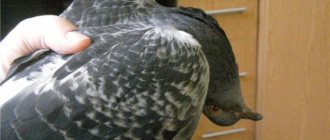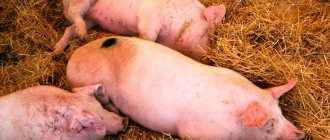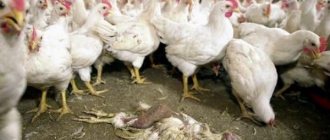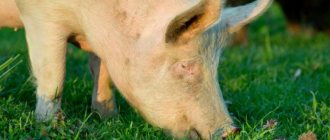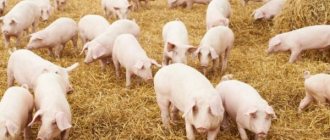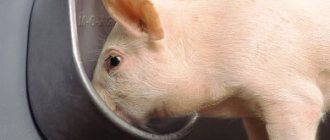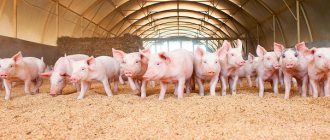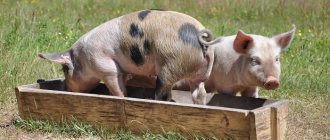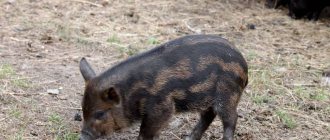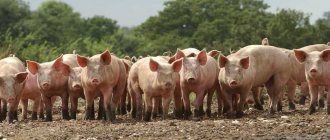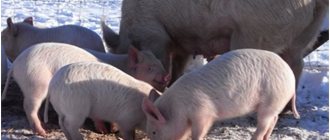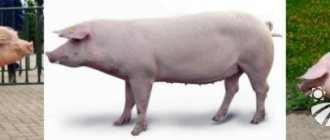The main concern of pig farmers is the health and growth of their pigs, and the greatest threat to this is classical swine fever (CSF). Against the background of plague infection, complex complex diseases can develop, which lead to mass mortality of adult pigs and young animals. Knowledge of the basic symptoms, principles of diagnosis, treatment, as well as the organization of correct preventive measures will help maintain the health of pigs.
Features and dangers of CSF
The classic type of swine fever is an infectious disease that often affects piglets and adult domestic breeds. In addition, wild boars also become victims of infection. This pathology is extremely contagious and spreads quickly through the feces of infected animals, feed, water, and beyond the boundaries of a particular herd.
This infectious disease provokes the development of lobar pneumonia, intestinal inflammatory processes, and hemorrhagic diathesis. Complex diseases often lead to mass death of animals inside livestock farms and cause the greatest harm to pig production.
Often, CSF in pigs occurs secretly and does not manifest itself in any way, and in individuals who have recovered from the disease, the disease does not develop, acquiring chronic forms. On the other hand, the infectious agent continues to spread through food, water, and damaged skin of animals.
Varieties of swine fever
The swine fever virus tends to mutate, so new strains arise periodically. However, there are 2 most famous and widespread types: classical swine fever (CSF) and African swine fever (ASF).
Did you know? Although the disease common to humans and pigs is called the same - plague, they are two completely different diseases. Plague, which is dangerous to humans, is caused by infection, and the cause of CSF and ASF is a virus. But both the human and porcine varieties of the disease have common features
—
high infectivity and mortality.
Classic shape
This form of the disease, which affects both domestic and wild pigs (boars), is transmitted mainly through waste products of infected animals (feces, saliva, all kinds of secretions). There are often cases of a latent course of the disease, without pronounced signs. It also happens that in animals that have suffered from the disease, it becomes chronic with a slow course and unexpressed symptoms.
The classic form is characterized by mass mortality of livestock and associated complications: pneumonia, enteritis, hemorrhagic diathesis. The cause of CSF is an RNA-containing togavirus, which is easily transmitted from an infected animal to a healthy one through water, food, direct contact, and microwounds. To combat the disease, there are several fairly effective types of vaccines that reduce the risk of contracting CSF disease.
African
At the beginning of the twentieth century, a new virus (Asfivirus) was discovered, which belongs to the amphoviruses and is the causative agent of African swine fever. The symptoms of both forms have many common details, but the African form is much more likely to be fatal. Livestock mortality can reach 99-100%. Due to the rapidity of the disease, even a large population can die completely within a few days. For quite a long time, the African plague occurred only in an acute form, but now it has become chronic.
Find out how to cure sarcoptic mange and erysipelas in pigs.
There are animals that only carry the infection, but this form of the disease is not as common as in the case of classic swine fever. The homeland of ASF, as the name suggests, is Africa, more precisely, its equatorial regions. But largely thanks to the development of world trade, and, accordingly, communications (especially maritime transport), the African plague became a frequent guest in Europe.
External symptoms of the disease
When animals are infected, the incubation period takes an average of 4-7 days, but can last up to three weeks. Symptoms of distemper in pigs include fever, damage to blood organs and vessels, and intestinal inflammation.
Acute and chronic development are characterized by the following signs of the disease:
- temperature rise to 42 degrees;
- loss of appetite, body weight, thirst;
- muscle spasms, paralysis of limbs, loss of general vital activity;
- hemorrhages on the skin of the abdomen, ears;
- purulent inflammation in the eyes and nose;
- digestive disorders - from diarrhea to constipation;
- vomiting and cough;
- leukopenia (decrease in the number of white blood cells);
- internal bleeding.
The infection is often accompanied by changes in skin color, the appearance of brown spots and bruising.
Possible complications of the viral process
In addition to the danger that CSF itself poses, it should also be said about the complications that can arise as a result of the disease. First of all, among the possible complications, it is necessary to distinguish both forms (intestinal and pulmonary) of the subacid variety of the disease.
Did you know? The mortality rate of classical swine fever is 80-100% of the total number of infected individuals.
In addition, complications can manifest themselves in the form of salmonellosis and pasteurellosis that additionally arise against the background of the plague. All 3 diseases lead to fairly rapid death.
Behavioral changes in animals during infection
The course of swine fever can have hyperacute, acute, subacute or chronic forms. Depending on this, animals experience external and behavioral changes. In the most extreme case, the body temperature of the sick piglet rises to 42 degrees, nausea, vomiting, refusal to feed, weakness, and lethargy appear. Pigs literally “burn out” in 2-3 days.
The acute course of the infection is accompanied by conjunctivitis, purulent discharge, and nosebleeds. The pig tries to hide under the bedding. There is apathy, weakness of the hind legs, convulsions, trembling, decreased activity, and digestive disorders. In such cases, the sick individual dies after 5-10 days.
Milder varieties of plague manifest themselves through muscle atrophy, weakness, hind legs tucked under the stomach, elevated temperature, drooping head and tail. Inflammation of the intestines and lungs and pleurisy often develop. Despite the longer course of the disease, the mortality rate of infected animals in such cases is high.
Signs and symptoms
The incubation period of CSF lasts from 1 to 9 days. Further, the plague can develop into one of 6 forms, the symptoms of which should be described separately.
Intestinal form
The following symptoms are characteristic:
- enterocolitis;
- fever;
- constipation or irregular bowel movements (periodically), during breaks - diarrhea;
- the animal stops eating.
Did you know? More than 500 outbreaks of ASF have been registered in Russia, and a population of more than 1 million individuals has been destroyed. Economic damage exceeds 30 billion rubles.
Pulmonary form
Typical signs are present:
- pneumonia develops;
- cough;
- the animal has difficulty breathing;
- nasal discharge;
- To reduce pain, gilts sit like a dog, with their hind limbs tucked under them and hunched over.
This form of the disease most often leads to death.
Chronic form
It is typical for farms where the livestock is vaccinated, but the living conditions and nutrition do not comply with the instructions and standards of the SES. The weakest animals begin to get sick first, then the virus spreads to other animals. Usually the disease lasts up to 8-9 weeks.
Read more about how to find out the weight of a pig.
The symptoms are:
- cough;
- the pig periodically loses interest in food;
- inflammation on the skin;
- the animal loses a lot of weight.
Pigs that survive remain carriers of the virus for approximately 1 year. At the same time, their immunity is extremely weak; animals are at increased risk of developing pasteurellosis and paratyphoid.
Acute form
The acute form of CSF is characterized by the following symptoms:
- body temperature rises to 41-42°C;
- 50-70 hours after the first symptoms appear, the animal loses its appetite;
- constant thirst;
- fever and vomiting;
- alternating bloody diarrhea and constipation;
- swelling of the eyelids, conjunctivitis, with severe purulence in the eyes;
- the animal noticeably stoops and tries to cover itself with bedding;
- paresis of the hind limbs;
- urine color is dark;
- blisters filled with yellow mucus appear on the body;
- spots on the skin of a dark red color, which increase in size and gradually combine into one large spot;
- blood is periodically released from the nose (patch);
- the ears, snout and tail acquire a purple tint;
- immediately before death, body temperature drops sharply to 35-36°C.
The acute form of CSF in young animals lasts 1-1.5 weeks. Sows give birth to dead offspring.
Find out how to treat worms in pigs and piglets.
Lightning form
This form of the disease is typical for piglets fed on mother's milk.
Manifestations of the disease are as follows:
- fever;
- depressed state;
- vomit.
The consequence of the disease is a coma or severe convulsions. A day or two after the first signs are detected, death usually occurs.
Subacid form
The subacid form, in turn, can occur in 2 subtypes:
- intestinal form;
- pulmonary
Characteristics of the plague pathogen
Microorganisms of a viral nature provoke the development of the disease in pigs. The classical plague virus provokes inflammation, hemorrhages in internal organs and blood vessels, leading to thinning of their walls. This is due to its ability to accumulate inside the body.
There are A, B, C varieties of the plague virus. Type C is of particular value for the development of pig immunity, since it is on its basis that a vaccine is created that counteracts their infection.
The causative agents of swine fever are highly resistant to adverse external factors. They die as a result of heat treatment at a temperature of 70-80 degrees for an hour. On the other hand, the microbe is resistant to drying and extremely low temperatures. For example, in corned beef it lasts up to 315 days, inside chilled meat and offal - up to 4 months.
When frozen, the plague pathogen does not die for several years. The dried state of the virus maintains the risk of infection inside barnyards and pigsties for up to one year.
Preventive actions
Preventive measures designed to protect pigs from infection with plague:
- Maintaining cleanliness in the pigsty and areas intended for walking.
- Regular disinsection and disinfection of the premises.
- Frequent change of bedding, control of feed preparation: drinking water is disinfected, food is subjected to heat treatment.
- Proper organization of a place for bathing pigs.
- Compliance with quarantine for newly arrived animals.
- Regular vaccination of pigs and routine examinations by a veterinarian.
- Installing a strong fence around the farm to prevent wild animals that could carry the virus from entering the area.
When plague is detected on a farm, infected individuals are slaughtered and the corpses are burned. Pigs that show no signs of the disease are required to be vaccinated, and the farm is quarantined for a period of 40 days. They carry out cleaning, disinfection, and destruction of manure. The land adjacent to the farm is plowed. During quarantine, it is prohibited to sell meat; products can only be exported to meat processing plants.
Ways of infection spread
Most often, infection of pigs with plague occurs through the esophagus, respiratory organs, and skin lesions. Although the main source of infection is food and water, there are many other ways the disease can spread.
Pathological manifestations can occur after transporting animals by contaminated transport. Rodents, pets, and worms can carry the dangerous virus. In addition, meat, lard, blood, and offal obtained from the slaughter of infected livestock stored on a pig farm can cause illness.
Distemper is transmitted from sows to suckling piglets. Depending on the type of viral agent, pigs may develop immunity from an early age or die. The classic form of the plague virus can spread in different ways at any time of the year.
Pathological changes
The following characteristic signs can be seen in pigs that have died as a result of the disease:
- The skin is covered with a large number of hemorrhages of various shapes and sizes.
- Enlarged lymph nodes are burgundy in color and, when opened, have a marble-like structure.
- Spots on the lungs.
- The heart is covered with hemorrhages.
- Enlarged spleen, covered with tears along the edges. This circumstance is the most typical sign of CSF.
- The kidneys have a whitish tint with noticeable traces of small hemorrhages.
- In the event that death occurs in the subacute phase, typical “plague buds” can be seen.
Pig immunity
If animals experience the disease and survive, they develop strong resistance to re-infection for the rest of their lives. Based on these characteristics of the pig’s body, veterinarians have developed a special viral vaccine. It is successfully used in pig farming to prevent infection in disadvantaged farms.
The live culture dry vaccine KS against classical swine fever has become widespread. After its administration, animals develop excellent immunity within a week. The pig's body's resistance to distemper lasts for more than one year.
The viral vaccine is the most universal, comprehensive way to prevent the classic type of plague.
From the moment of birth, piglets are immunized orally. Vaccination increases the likelihood of maintaining a healthy pig farm population. At home, it is important to promptly and correctly vaccinate pigs against plague.
How do pigs become infected?
The ASF virus enters the body of animals aerogenously (airborne), alimentary, through damaged mucous membranes, skin, and conjunctiva. Infection is possible through equipment and household items contaminated with pathogens that were used in caring for sick pigs. low-quality feed. Unheated food that is fed to animals can also cause infection with the ASF virus.
The source of spread of the deadly infection is infected sick individuals, animals during the incubation period, and recovered pigs. Intermediate carriers of the disease include rodents, wild birds, and blood-sucking insects.
Having penetrated the body of a piglet or an adult, the pathogen infects macrophages, which leads to the activation of transcription of free genes for the body's response. The ASF virus is localized in the endothelial cellular structures of blood and lymph vessels, in mononuclear phagocytes, myeloid and lymphoid tissues of the immune system.
The virus, as its number increases in the body of sick animals, has a cytopathic effect on lymphocytes and endothelial cells. Over time, necrosis of the vascular walls develops, and the porosity of the vessels increases. Reproduction of the virus is accompanied by a cytopathic effect on lymphocytes, macrophages and endothelial cells.
Due to fibrinoid necrosis of the endothelium of blood vessels, the permeability of the vascular walls sharply increases, venous and inflammatory hyperemia, thrombosis, and leukopenia appear.
Numerous hemorrhages are visible on the serous, mucous membranes, skin, and parenchymal organs after autopsy of animal corpses. Extensive necrosis of myeloid tissues forms in the lymph nodes, bone marrow, and spleen. In sick pigs, the immune potential decreases, the immune defense weakens, and the body's natural resistance decreases. The disease is fatal in 100% of cases.
Diagnosis of the classic form of the disease
To make a correct diagnosis, primary signs such as general weakness, lethargy, decreased appetite, and increased body temperature of animals are essential. On the other hand, such manifestations are characteristic of many other diseases, in particular ASF. More information about this infection can be found in the article “Causes and symptoms of African swine fever.”
A typical clinical picture of the classical form of pathology is revealed only in certain ways using clinical, laboratory, biological, epizootological, and pathoanatomical research methods. An accurate diagnosis is only possible with an integrated approach.
The most important clinical indicators of the disease are leukopenia, the presence of protein in the urine, and hemorrhagic diathesis. Often a special biological test is carried out targeting a control group of animals with developed immunity.
The plague virus is studied using fluorescent antibodies. It consists of studying smears, sections of lymph nodes, and the spleen of infected animals.
The African variety of plague is distinguished from its classical form using a serological blood test.
Danger to people
Classical or African swine fever is not dangerous to humans. But, since pathogens and their varieties have not been studied enough, the answer to the question of private farm owners: “Is it possible to eat the meat of sick pigs?” is negative. The virus that affects livestock is capable of mutations and remains in animal meat for up to 150 days, which means it is impossible to predict its changes and impact on human health. Therefore, veterinary services do not provide for therapeutic measures, but carry out measures to eliminate infected and nearby livestock. This is the only measure currently available to prevent the occurrence of epidemics and pandemics.
The plague itself does not pose a danger to humans, but eating animal meat is prohibited
If classical or African swine fever is suspected, a reminder to the public reads:
- It is necessary to call a veterinarian;
- If the diagnosis is confirmed, send the cattle for slaughter and disinfect utility rooms, all equipment and work clothes;
- New animals can be bred only after observing a 40-day quarantine.
Classical or African swine fever, how is the infection dangerous for humans? Nothing for people's health. However, for owners of farms or subsidiary plots, the arrival of the plague is a real disaster, a huge loss and emotional shock. This is why it is so important to vaccinate livestock. This procedure cannot guarantee 100% elimination of infection, but is considered one of the most effective measures for early prevention of plague.
Possible complications arising from CSF
The chronic course of the disease can lead to some complications, which may manifest as symptoms of porcine intestinal and respiratory disorders.
For example, when a patient with classical swine fever is infected with salmonellosis, severe digestive disorders of the animal occur, which are expressed in severe bloody diarrhea with purulent inclusions. As a result, pigs catastrophically quickly lose strength and weight and inevitably die.
If pasteurellosis is superimposed on the clinical picture of classical distemper, then the characteristic manifestations in such cases are a severe cough, attacks of which literally plague the animal against the background of purulent discharge from the nose and bleeding of the oral mucosa.
In some cases, mixed complications of the disease are possible, in which the above symptoms are summed up. With such a development of the disease, the death of animals is inevitable.
Methods of transmission of the virus
The source of the virus is a sick pig. Also, African plague is transmitted from virus carriers, which can be people, insects, birds and animals.
This disease, which affects domestic pigs, is transmitted in the following ways:
- as a result of close contact of a sick animal with a healthy one: infection occurs through the oral cavity, skin, mucous membranes of the eyes;
- through contaminated food waste, as well as equipment intended for slaughtering pigs;
- from domestic animals, birds, rodents, insects and people who were in an infected area - a slaughterhouse or warehouse;
- through the bite of a virus-carrying tick;
- through vehicles that were contaminated when transporting sick pets;
- through food waste that is added to pig feed without first treating it appropriately.
The duration of the incubation period of the disease is about 5-10 days.
This disease does not pose a danger to the human body, since it is not sensitive to the virus of this type. However, humans are capable of acting as a virus carrier and infecting pigs upon contact with them.
Modern methods of fighting infection
In the early stages of plague infection, piglets were treated with hyperimmune sera. The effectiveness of such therapeutic measures depended on the stage of the animal's disease. Today, there is a developed pharmacological complex that gives excellent results in the early stages of infection. It is important to identify the disease in time and take appropriate measures.
In general, there is no treatment for CSF, so the vaccine remains the main method of combating swine viral pathology. The complex vaccination method, which is aimed at preventing plague, erysipelas, and Aujeszky's disease, has shown high effectiveness in practice. Adult animals are vaccinated once every ten months, and piglets are administered the drug in an amount of 2 ml on the 50th and 75th day of life. It is important to use the product within 3-4 hours after preparation. A responsible and attentive attitude to such procedures will help maintain the health of pigs.
General preventive measures
The main goal of preventive measures is to prevent the virus from entering areas where pigs are kept.
To do this, you must follow these rules:
- The farm must be well fenced; wild animals should not be allowed into it.
- It is necessary to equip disinfection at the entrance, including an antiseptic mat and a sanitary checkpoint.
- Overalls are required for farm workers.
- It is unacceptable even to temporarily keep pigs outside the farm walls, in private farms of personnel (for example, during disinfection work).
- It is necessary to develop and strictly implement measures for disinfection and the destruction of parasitic insects and rats.
- Regularly disinfect all equipment and vehicles.
- Pigs that have just arrived on the farm must first be kept in quarantine.
- Disinfection of water and heat treatment of food waste are mandatory.
Vaccination
The most effective measure to prevent CSF is vaccination, which can be standard or using a concentrate. One ampoule of the standard vaccine contains 1 thousand doses, the concentrate contains 1 million.
Use of standard vaccine
The standard vaccine is used as follows: an injection is given in the lower third of the neck (can be in the inner thigh) in a volume of 2 ml.
We recommend that you find out why you need a growth stimulator for pigs.
If the sanitary and epidemiological situation on the farm is normal, vaccination is carried out in the following order:
- Sows are immunized 2-3 weeks before each mating.
- Boars are vaccinated once a year.
- Piglets are vaccinated for the first time at the age of about 1.5 months, and re-vaccinated at 3 months.
If signs of disease appear in a small private farm, absolutely all animals that do not have symptoms of the disease, including pregnant ones, should be vaccinated. The vaccination is done regardless of the timing of the previous one.
Those animals whose condition may be in doubt must be observed for 15 days. For animals that have been immunized, the timing of the possibility of eating meat is not determined, and the sale of breeding animals is permissible 12 days after vaccination.
Application of concentrated vaccine
The concentrate is used in large livestock complexes when there is a threat of epidemic. All animals without signs of clinical manifestations are vaccinated. The immunization procedure is the same as for the standard vaccine. Pregnant sows are also vaccinated a month before farrowing. Immunization is carried out until there are absolutely no signs of disease left on the farm.
Acute form of the disease
With this course of the disease, the animal usually dies within 1 week from the moment the first signs appear. Often the individual may fall into a coma. The first days of the disease are accompanied by a constant fever at a temperature elevated to 40-41°C, which after a few days drops slightly. The animal feels weak and depressed.
Important! 2-3 days after the onset of the disease, signs of anorexia, chills, vomiting and constipation appear. Constipation is replaced by diarrhea with the presence of blood streaks and clots in the stool.
As it progresses, conjunctivitis occurs - the eyelids begin to swell, mucopurulent exudate is released, causing them to stick together. Other signs include:
- ataxia;
- yellow pustules in the abdomen, thighs, ears;
- subcutaneous hemorrhages of a pinpoint type, caused by thinning of the vascular walls and subsequently merging into dark purple spots that do not disappear after pressure.
With the acute development of CRS, breathing becomes difficult and gradually becomes more frequent. Heart failure develops, which causes cyanosis on the patch, ears, and skin of the abdomen and legs. The development of leukopenia is observed. The animal dies within 7-10 days.
Often the disease is accompanied by the acquisition of a nervous form of disorders with the manifestation of convulsive contractions of muscle groups. Manege movements appear and paralysis of the hind legs is diagnosed. Due to nervous excitement, the individual may die within 1-2 days.
Danger of the ASF virus to humans
There is no clear answer about the danger of the virus to humans.
After conducting a series of experiments, scientists discovered that the known strains of the ASF virus do not pose a danger to the human body.
However, like other viruses, the virus of this disease is constantly changing and it is difficult to predict the further course of events, especially since it is so far the only representative of the asphavirus family and an increase in varieties can be expected quite soon.
Today there has not been a single confirmed case of human infection with ASF, but viruses undermine the human immune system. Scientists from a number of countries confirm the data on the reaction of antibody production in the body against this virus.
All this establishes the fact that it entered the human body and attempted infection. It is possible that a person is exposed to this disease without pronounced symptoms.
The most alarming studies are in tropical countries, which are the primary sources of this virus. The latest diagnostic technique has confirmed that the ASF virus was found in people who had had tropical fever.
Ways to solve the problem
African swine fever virus spreads at a high rate. It is prohibited to carry out therapeutic measures; the only way out is the complete destruction of infected individuals. There is currently no adequate treatment for pigs suffering from African swine fever.
When an infectious process spreads, it is necessary first of all to determine the boundaries of the source of infection and declare a quarantine regime.
All individuals infected with African plague must be destroyed using a bloodless method. The area where it is planned to slaughter animals infected with the virus must be isolated.
The bodies of dead and destroyed pigs, as well as their waste products, leftover feed and equipment are burned. The same must be done with feeding troughs, partitions, and dilapidated rooms. The resulting ash must be mixed with lime and buried in the ground. The depth must be at least 1 m.
All rooms in which animals stayed must be treated with special solutions. This needs to be done 3 times, with an interval of 3-5 days. For disinfection, use a solution of bleach and sodium hypochloride.
All pig farms located within 25 km of the infection zone are slaughtered, even if the pigs are healthy.
Quarantine after detection of African swine fever lasts at least 40 days. During this period, it is prohibited to export any products obtained from animals (even if they are not obtained from pigs) outside the zone. For six months after the outbreak of infection, the export and sale of any agricultural plant products is prohibited.
Activities related to the elimination of the African swine fever epidemic must be provided by veterinary services.
General control measures
There is no cure for the plague. The disease is particularly dangerous, therefore, when a final diagnosis is made, a quarantine is imposed on the pig farm. All pigs from small farms and individual subsidiary plots are slaughtered in a bloodless manner and destroyed by burning.
Burning corpses
Clinically healthy animals are vaccinated. At enterprises with industrial technology, pigs are slaughtered and subsequently processed into canned food. Pork carcasses unsuitable for human consumption are processed into meat and bone meal. Clinically healthy livestock are immunized.
Under quarantine conditions, general restrictions are applied that are typical for other infectious diseases.
Quarantine
Quarantine from a point unreliable according to the CoES is canceled 30 days after death, illness or slaughter. This requires disinfection. other activities in accordance with veterinary legislation. After quarantine is lifted, all pigs are immunized with the CSF vaccine for three years.
Chronic form
When the animal survives the subacute form, the disease enters the chronic stage. In this case, the infection is active in the body for several months. Signs of this condition will be:
- severe lobar-diphtheroid lesions of the gastrointestinal tract;
- purulent-fibrinous inflammation in the lungs;
- pleurisy;
- alternating diarrhea and constipation;
- progressive emaciation;
- increased temperature background;
- complication by secondary type infections (salmonellosis and pasteurellosis), which provokes an exacerbation of the disease and death of the pig;
- manifestation of abortions and stillbirths.
Infection of the fetus occurs through the placenta. Piglets are faced with a chronic form of CSF, which causes death at the age of 1-2 months. The main reason for the chronic development of plague is the active reproduction of virulent strains in a weak immune organism or in the case of an inactivated vaccine.
